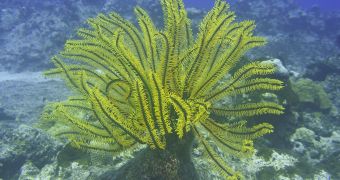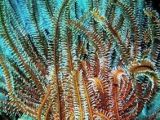Sea can be as deceptive as a mermaid. There are sea anemones or sea cucumbers, and none of them are plants. There are even sea lilies, only that these "flowers" are related to starfish, sea urchins and... sea cucumbers.
Crinoids or sea lilies amaze us through their diversified shapes and colors. Sea lilies are amongst the oldest living creatures. Many live stuck on coral reefs, that's why some call them coral flowers.
The largest species concentration is found in the seas of Indonesia, but many species are found also in the Mediterranean Sea.
Having a bad taste, few species feed on them, that's why predation does not bother them much. Sea lilies fix on corals, but not everywhere. They abound on the more outstanding areas, exposed to sea currents.
The arms of the sea lilies are their main trait; they are long and covered with feather-like formations that stretch and roll, folding and unfolding. The "feathers" gather food made of small particles and organisms, which are headed to the mouth. In other words, sea lilies filter nutrients from the water. Arms can help sea lilies swim and regenerate if lost because of a predator or accident. The central body of the "flower" harbors the mouth, the gut and the anus.
The arms are rotated with precision in the direction of the current. Many species keep their arms retreated during the day time (when they do not eat), opening their arms only during the night. Inside the closed "corolla" of the sea lilies, shrimps, crabs and sea worms can find a protective shelter. The outer skeleton of the sea lilies, located in their skin, is made of tough calcareous plates.
Even if sea lilies look immobile, they can move to other site in the search for a better feeding ground.
These animals are living fossils. Their highest diversity occurred during the Ordovician era (490-440 million years ago). They still survive due to the adaptation for living at huge depths. The highest species diversity is seen at depths beyond 90 m (300 ft). Sea lilies have been collected at depths of 6,000 m (20,000 ft).

 14 DAY TRIAL //
14 DAY TRIAL // 
